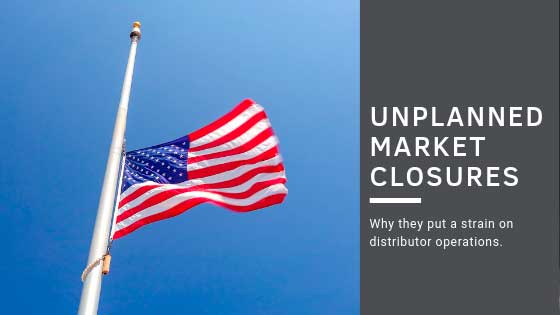Unexpected market closures, like the one we experienced recently for the funeral of former President George H. W. Bush, put the mutual fund industry in a precarious position. And while they don’t occur very often, when they do — it puts operations teams under serious strain, especially on the distribution side.
While market closures are a straightforward activity for brokers and exchanges (it is treated as a “non-business day”), fund companies must make a few, key decisions about how they’re going to handle the unplanned closure, and in turn, communicate that to their distributors and intermediaries. Will they be open? Will they be accepting trades? Will they calculate a NAV for the day? How will they handle daily accrual rates and dividend pay dates?
Last week’s closure, banks, and the DTCC remained open, meaning it’s still possible for fund trades and redemptions to be executed. This situation brings to the table a number of critical pieces of information required to ensure a firm is handling their trading correctly the day the markets are closed. The simplest of the questions posed to the Funds is whether they will be open. But even this basic request-response likely generated tens of thousands of emails and phone calls between funds and firms. As previously mentioned, there are other critical decisions that must be made and communicated downstream to the fund’s intermediaries that required far more back and forth — and the conversation was multiplied by the hundreds of industry participants on both the fund and dealer side.
- Take daily accrual rates (DARs) for example. There are three basic ways funds can calculate and communicate DARs to its distributors: (1) funds can create a DAR combining the rates for the last open day plus the day of closure; (2) a DAR combining the day of closure and the day after the closure; or (3) a DAR for the day of closure posted separately alongside the next day’s DAR.

- With each new variable comes more complexity that the distributor must sort out. On a one-fund-to-one-distributor basis, this doesn’t seem like it would add much more than a few keystrokes. But consider that most distributors work with hundreds of fund companies. Keeping up with the myriad of changes coming through requires meticulous organization and a coordinated effort across an operations team to ensure the day of the market closure, as well as the following day, goes smoothly.
- Regardless of what each fund decides to do, distributing clear communication about their plans is of the utmost importance. From there, it’s the responsibility of the distribution partners to keep track of these adjustments and operate accordingly.
Delta Data’s FundBlast
We worked hard alongside our distribution clients last week to . Although it was exciting and reassuring to see the industry come together and communicate information, there appeared to be a lack of an efficient method.
Delta Data’s FundBlast is designed and optimized to help facilitate the future of communications between asset managers and their distribution partners. We took notes and hope that the next event will be a more crisp and timely communication for our clients and users of FundBlast.
And if you’re interested in learning more about how we’re re-building the mutual fund communication ecosystem, visit our FundBlast homepage for more information.

